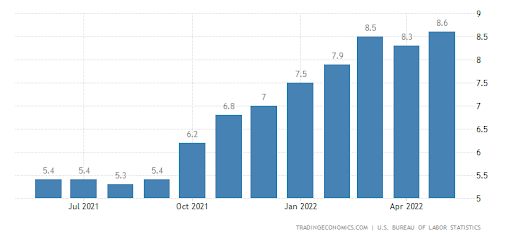The S&P 500 index is down nearly 20% since the beginning of the year and the volatility could continue throughout the rest of the year. While ETFs have better liquidity and tax efficiency than mutual funds, passively managed ETFs don’t offer much protection from downside risk. As a result, actively managed ETFs have become an increasingly popular safe haven.
Let’s look at how actively managed ETFs can help during market volatility and some options to consider for your portfolio.
See our Active ETFs Channel to learn more about this investment vehicle and its suitability for your portfolio.
What’s Behind the Volatility?
The S&P 500 index’s dramatic move lower began in April, shortly after Russia invaded Ukraine and inflation began to spiral out of control. Since then, the central bank has raised interest rates by 75 basis points in an effort to curb inflation, putting the economy at risk of a recession. As a result, investors have been adjusting their outlook for the equity and debt markets.

Inflation reached its highest levels since December 1981 in May 2022. Source: TradingEconomics
In addition to these concerns, U.S. stocks had already been expensive compared to their historical valuations. The S&P 500 index’s Shiller (inflation-adjusted) P/E ratio currently stands at more than 30x, according to Multpl.com. These levels have fallen over the past few months but remain well above the all-time average of about 17×.
Unfortunately, many uncertainties remain that could keep volatility at elevated levels. The Federal Reserve’s ability to control inflation remains to be seen and global concerns over the Russia-Ukraine crisis and China’s COVID-19 lockdowns persist. However, these effects may be somewhat offset by higher household wealth and pent-up consumer demand.
Three Active ETFs to Fight Volatility
Actively managed ETFs are ideal vehicles to capitalize on specific opportunities. For instance, some funds attempt to maximize dividends by opportunistically investing in dividend-paying stocks or preferred stocks. Meanwhile, others attempt to identify undervalued stocks using price-earnings ratios and other financial metrics.
Actively managed ETFs focused on managing volatility include:
- Vanguard U.S. Multifactor ETF (VFMF) – The Vanguard U.S. Multifactor ETF uses a quantitative strategy to remove the most volatile stocks from consideration. Then, it ranks the remaining stocks by momentum, fundamentals, and value, yielding a portfolio that could be less volatile than the underlying index.
- First Trust Long/Short Equity ETF (FTLS) – The First Trust Long/Short Equity ETF invests in a portfolio of long and short equity positions, creating a market-neutral portfolio. As a result, the fund doesn’t suffer as much when the market falls or benefit as much when the market rises (e.g., it has lower volatility).
- JPMorgan Equity Premium Income ETF (JEPI) – The JPMorgan Equity Premium Income ETF generates a monthly income by selling options and investing in U.S. large-cap stocks. With a focus on a low-volatility equity portfolio, the fund offers income investors a less volatile option to generate portfolio income.
While some passive smart-beta ETFs offer similar capabilities (e.g., low-vol ETFs), actively managed funds typically layer on added benefits. For instance, the JEPI adds income generation on top of a low volatility strategy while the VFMF considers fundamentals and momentum in its investment strategy.
A Growing Number of Options
The Securities and Exchange Commission (SEC) made it easier for asset managers to launch actively managed ETFs in 2019, meaning investors could soon have more options. Under Rule 6c-11, better known as the ETF Rule, issuers can bring funds to market without the cost and delay of obtaining an exemption. The agency also approved active non-transparent ETFs (ANTs).
In the aftermath of the new rule, the number of actively managed ETFs ballooned to more than 800 funds managing over $300 billion in assets, representing a 161% compound annual growth rate in assets under management over the past three years. These trends are likely to continue with a backlog of more than 80 active ETFs today.
The Bottom Line
Actively managed ETFs offer investors a reprieve from market volatility. By adding these funds to their portfolio, you can help sidestep some market volatility while achieving other goals, such as income. And with the SEC’s more lenient rules and a backlog of more than 80 active ETFs, investors could soon have even more options.
Take a look at our recently launched Model Portfolios to see how you can rebalance your portfolio.





